Abstract
Production and specific growth rates of attached and free-living bacteria were estimated in an oligotrophic marine system, La Salvaje Beach, Vizcaya, Spain, and in a freshwater system having a higher nutrient concentration, Butron River, Vizcaya, Spain. Production was calculated from [methyl-3H]thymidine incorporation by estimating specific conversion factors (cells or micrograms of C produced per mole of thymidine incorporated) for attached and free-living bacteria, respectively, in each system. Conversion factors were not statistically different between attached and free-living bacteria: 6.812 × 1011 and 8.678 × 1011 μg of C mol−1 for free-living and attached bacteria in the freshwater system, and 1.276 × 1011 and 1.354 × 1011 μg of C mol−1 for free-living and attached bacteria in the marine system. Therefore, use of a unique conversion factor for the mixed bacterial population is well founded. However, conversion factors were higher in the freshwater system than in the marine system. This could be due to the different trophic conditions of the two systems. Free-living bacteria contributed the most to production in the two systems (85% in the marine system and 67% in the freshwater system) because of their greater contribution to total biomass. Specific growth rates calculated from production data and biomass data were similar for attached and free-living bacteria.
Full text
PDF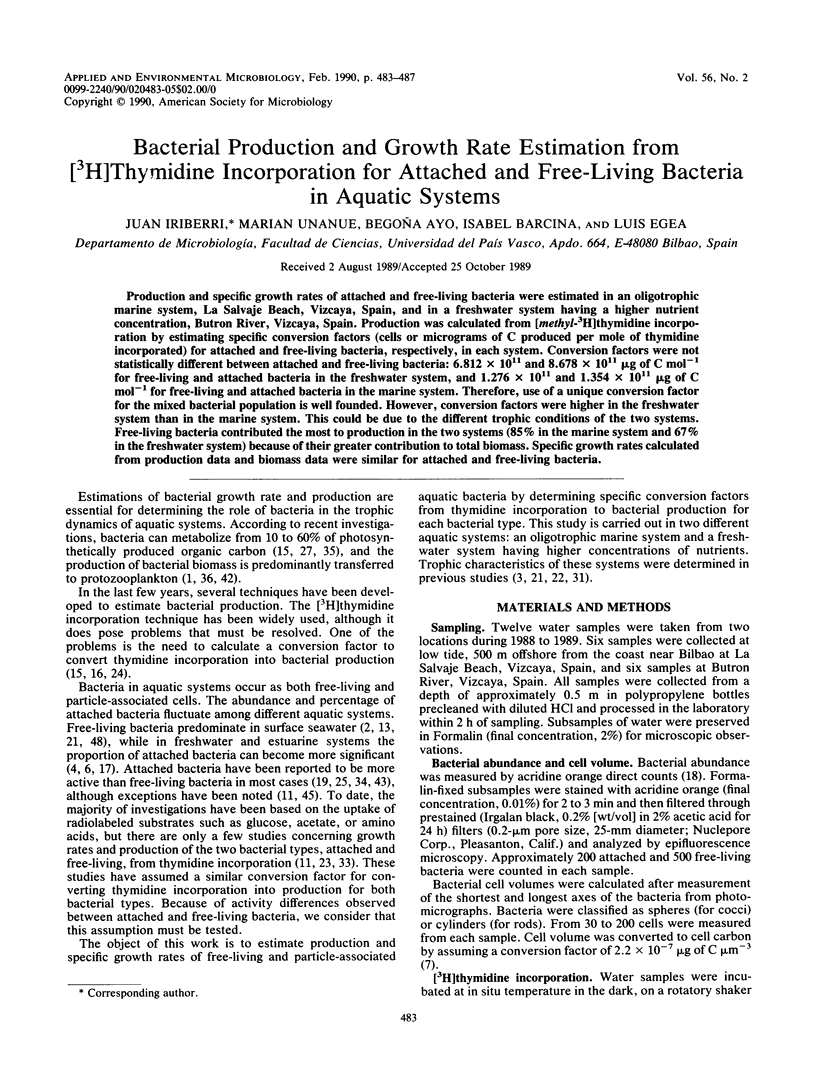
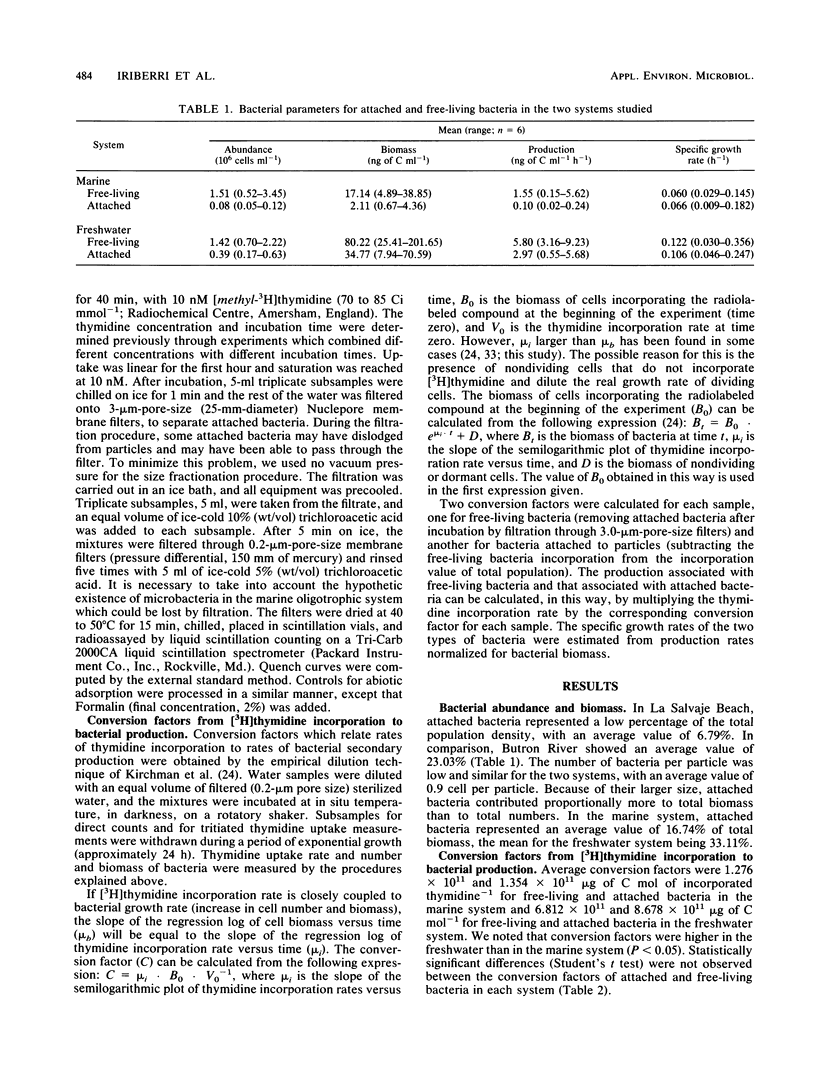
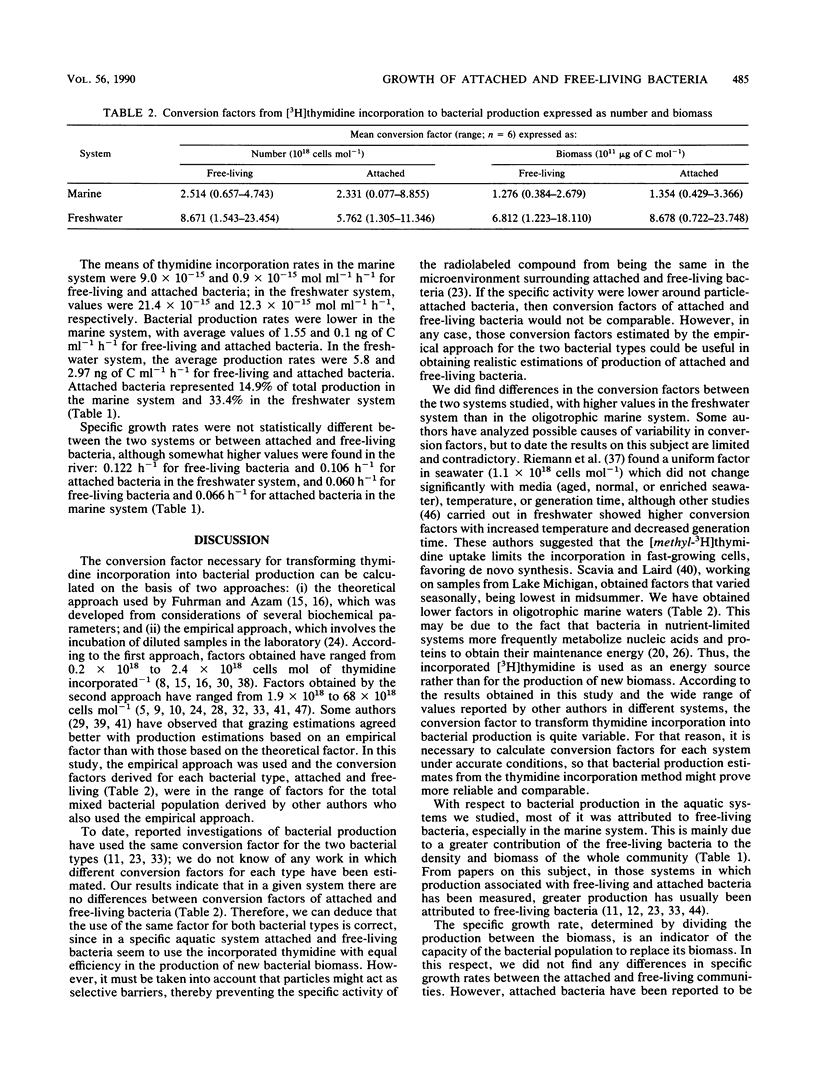
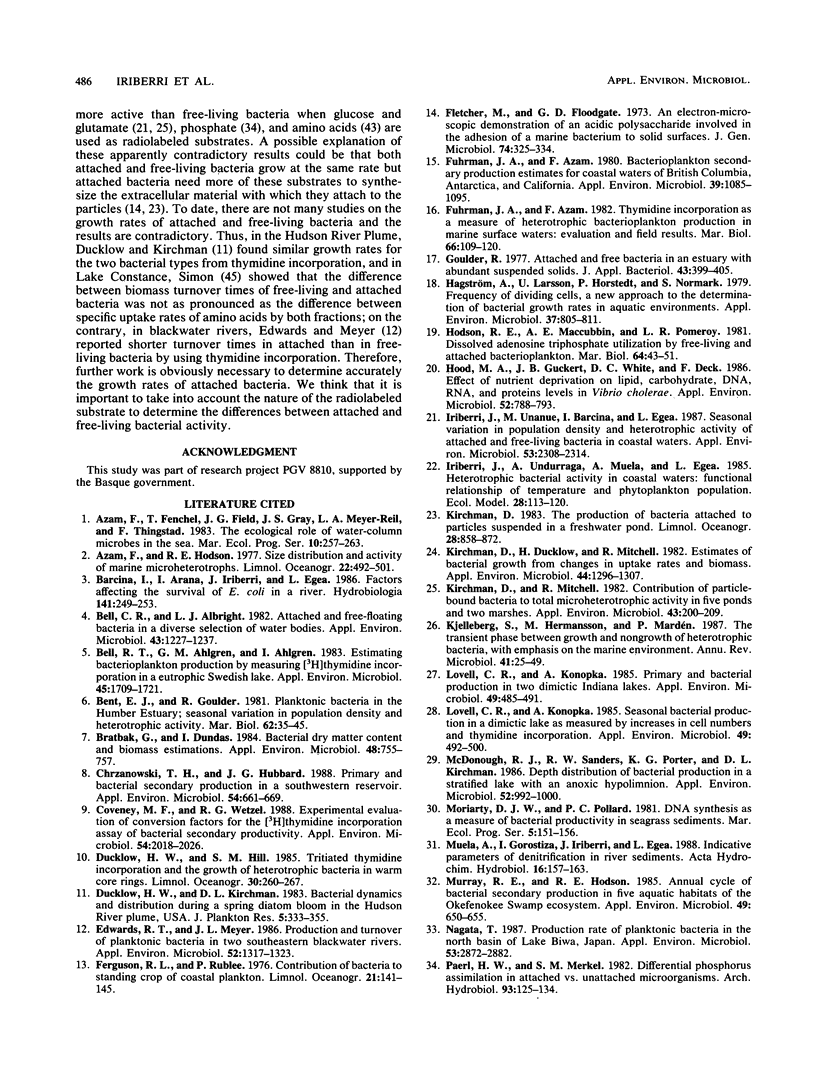
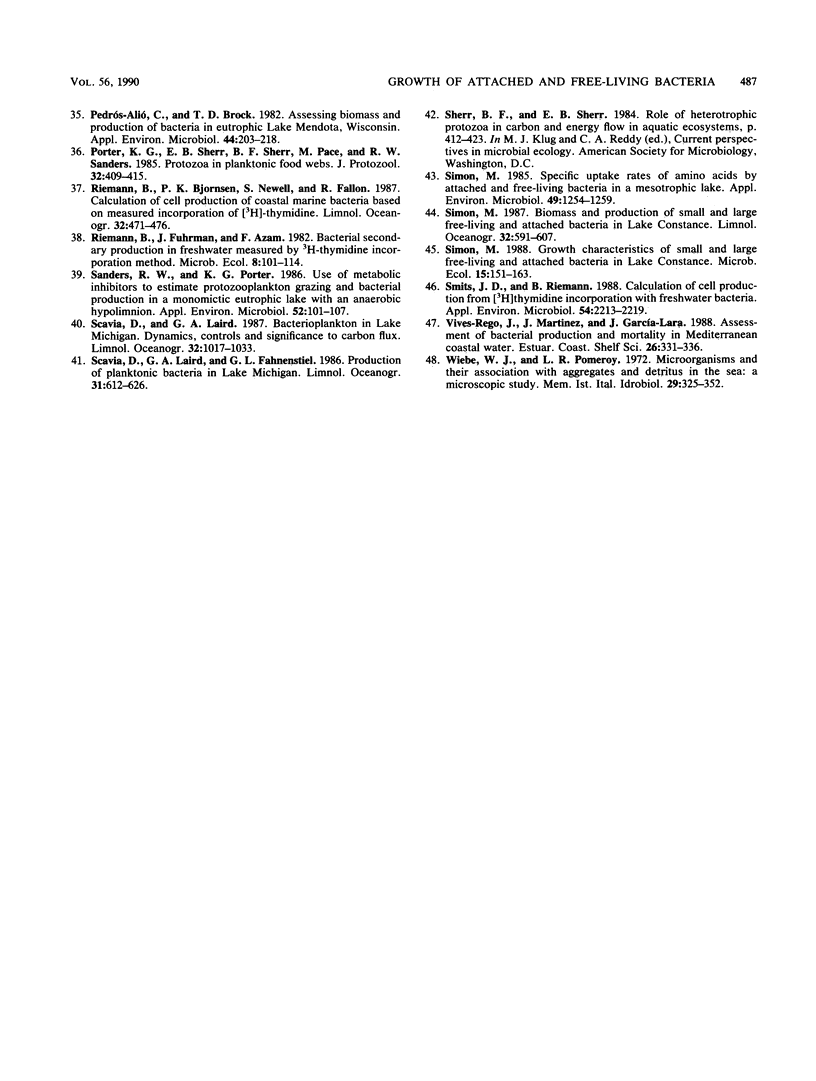
Selected References
These references are in PubMed. This may not be the complete list of references from this article.
- Bell C. R., Albright L. J. Attached and free-floating bacteria in a diverse selection of water bodies. Appl Environ Microbiol. 1982 Jun;43(6):1227–1237. doi: 10.1128/aem.43.6.1227-1237.1982. [DOI] [PMC free article] [PubMed] [Google Scholar]
- Bell R. T., Ahlgren G. M., Ahlgren I. Estimating Bacterioplankton Production by Measuring [H]thymidine Incorporation in a Eutrophic Swedish Lake. Appl Environ Microbiol. 1983 Jun;45(6):1709–1721. doi: 10.1128/aem.45.6.1709-1721.1983. [DOI] [PMC free article] [PubMed] [Google Scholar]
- Bratbak G., Dundas I. Bacterial dry matter content and biomass estimations. Appl Environ Microbiol. 1984 Oct;48(4):755–757. doi: 10.1128/aem.48.4.755-757.1984. [DOI] [PMC free article] [PubMed] [Google Scholar]
- Chrzanowski Thomas H., Hubbard James G. Primary and Bacterial Secondary Production in a Southwestern Reservoir. Appl Environ Microbiol. 1988 Mar;54(3):661–669. doi: 10.1128/aem.54.3.661-669.1988. [DOI] [PMC free article] [PubMed] [Google Scholar]
- Coveney M. F., Wetzel R. G. Experimental evaluation of conversion factors for the [h]thymidine incorporation assay of bacterial secondary productivity. Appl Environ Microbiol. 1988 Aug;54(8):2018–2026. doi: 10.1128/aem.54.8.2018-2026.1988. [DOI] [PMC free article] [PubMed] [Google Scholar]
- Edwards R. T., Meyer J. L. Production and turnover of planktonic bacteria in two southeastern blackwater rivers. Appl Environ Microbiol. 1986 Dec;52(6):1317–1323. doi: 10.1128/aem.52.6.1317-1323.1986. [DOI] [PMC free article] [PubMed] [Google Scholar]
- Fuhrman J. A., Azam F. Bacterioplankton secondary production estimates for coastal waters of british columbia, antarctica, and california. Appl Environ Microbiol. 1980 Jun;39(6):1085–1095. doi: 10.1128/aem.39.6.1085-1095.1980. [DOI] [PMC free article] [PubMed] [Google Scholar]
- Hagström A., Larsson U., Hörstedt P., Normark S. Frequency of dividing cells, a new approach to the determination of bacterial growth rates in aquatic environments. Appl Environ Microbiol. 1979 May;37(5):805–812. doi: 10.1128/aem.37.5.805-812.1979. [DOI] [PMC free article] [PubMed] [Google Scholar]
- Hood M. A., Guckert J. B., White D. C., Deck F. Effect of nutrient deprivation on lipid, carbohydrate, DNA, RNA, and protein levels in Vibrio cholerae. Appl Environ Microbiol. 1986 Oct;52(4):788–793. doi: 10.1128/aem.52.4.788-793.1986. [DOI] [PMC free article] [PubMed] [Google Scholar]
- Iriberri J., Unanue M., Barcina I., Egea L. Seasonal variation in population density and heterotrophic activity of attached and free-living bacteria in coastal waters. Appl Environ Microbiol. 1987 Oct;53(10):2308–2314. doi: 10.1128/aem.53.10.2308-2314.1987. [DOI] [PMC free article] [PubMed] [Google Scholar]
- Kirchman D., Ducklow H., Mitchell R. Estimates of bacterial growth from changes in uptake rates and biomass. Appl Environ Microbiol. 1982 Dec;44(6):1296–1307. doi: 10.1128/aem.44.6.1296-1307.1982. [DOI] [PMC free article] [PubMed] [Google Scholar]
- Kirchman D., Mitchell R. Contribution of particle-bound bacteria to total microheterotrophic activity in five ponds and two marshes. Appl Environ Microbiol. 1982 Jan;43(1):200–209. doi: 10.1128/aem.43.1.200-209.1982. [DOI] [PMC free article] [PubMed] [Google Scholar]
- Kjelleberg S., Hermansson M., Mårdén P., Jones G. W. The transient phase between growth and nongrowth of heterotrophic bacteria, with emphasis on the marine environment. Annu Rev Microbiol. 1987;41:25–49. doi: 10.1146/annurev.mi.41.100187.000325. [DOI] [PubMed] [Google Scholar]
- Lovell C. R., Konopka A. Primary and bacterial production in two dimictic indiana lakes. Appl Environ Microbiol. 1985 Mar;49(3):485–491. doi: 10.1128/aem.49.3.485-491.1985. [DOI] [PMC free article] [PubMed] [Google Scholar]
- Lovell C. R., Konopka A. Seasonal bacterial production in a dimictic lake as measured by increases in cell numbers and thymidine incorporation. Appl Environ Microbiol. 1985 Mar;49(3):492–500. doi: 10.1128/aem.49.3.492-500.1985. [DOI] [PMC free article] [PubMed] [Google Scholar]
- McDonough R. J., Sanders R. W., Porter K. G., Kirchman D. L. Depth distribution of bacterial production in a stratified lake with an anoxic hypolimnion. Appl Environ Microbiol. 1986 Nov;52(5):992–1000. doi: 10.1128/aem.52.5.992-1000.1986. [DOI] [PMC free article] [PubMed] [Google Scholar]
- Murray R. E., Hodson R. E. Annual cycle of bacterial secondary production in five aquatic habitats of the okefenokee swamp ecosystem. Appl Environ Microbiol. 1985 Mar;49(3):650–655. doi: 10.1128/aem.49.3.650-655.1985. [DOI] [PMC free article] [PubMed] [Google Scholar]
- Nagata T. Production rate of planktonic bacteria in the north basin of lake biwa, Japan. Appl Environ Microbiol. 1987 Dec;53(12):2872–2882. doi: 10.1128/aem.53.12.2872-2882.1987. [DOI] [PMC free article] [PubMed] [Google Scholar]
- Pedrós-Alió C., Brock T. D. Assessing biomass and production of bacteria in eutrophic lake mendota, wisconsin. Appl Environ Microbiol. 1982 Jul;44(1):203–218. doi: 10.1128/aem.44.1.203-218.1982. [DOI] [PMC free article] [PubMed] [Google Scholar]
- Sanders R. W., Porter K. G. Use of metabolic inhibitors to estimate protozooplankton grazing and bacterial production in a monomictic eutrophic lake with an anaerobic hypolimnion. Appl Environ Microbiol. 1986 Jul;52(1):101–107. doi: 10.1128/aem.52.1.101-107.1986. [DOI] [PMC free article] [PubMed] [Google Scholar]
- Simon M. Specific uptake rates of amino acids by attached and free-living bacteria in a mesotrophic lake. Appl Environ Microbiol. 1985 May;49(5):1254–1259. doi: 10.1128/aem.49.5.1254-1259.1985. [DOI] [PMC free article] [PubMed] [Google Scholar]
- Smits J. D., Riemann B. Calculation of cell production from [h]thymidine incorporation with freshwater bacteria. Appl Environ Microbiol. 1988 Sep;54(9):2213–2219. doi: 10.1128/aem.54.9.2213-2219.1988. [DOI] [PMC free article] [PubMed] [Google Scholar]


